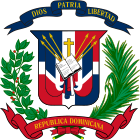| |||||||||||||||||||||||||
|
| |||||||||||||||||||||||||
Presidential election | |||||||||||||||||||||||||
| Turnout | 55.29% ( | ||||||||||||||||||||||||
|---|---|---|---|---|---|---|---|---|---|---|---|---|---|---|---|---|---|---|---|---|---|---|---|---|---|
| |||||||||||||||||||||||||
 Presidential election results by district | |||||||||||||||||||||||||
| |||||||||||||||||||||||||
 |
|---|
|
|
General elections were held in the Dominican Republic on 5 July 2020 to elect a president, vice-president, 32 senators and 190 deputies. They had originally been planned for 17 May, but were postponed due to the coronavirus pandemic.[1][2] They are the second elections since 1994 in which all positions will be elected simultaneously, and the first in Dominican history in which all authorities will be elected simultaneously and directly.[3][4][5][6]
Incumbent President Danilo Medina was ineligible to stand for re-election, having served two consecutive terms since 2012. The governing Dominican Liberation Party's 16-year rule ended after Modern Revolutionary Party candidate Luis Abinader received a majority of the vote.[7] Rival candidates Gonzalo Castillo and Leonel Fernández also conceded defeat.[7] The Modern Revolutionary Party also won a majority of seats in the Senate and a plurality in the Chamber of Deputies. The election was a partial realignment, with the Modern Revolutionary Party entering a status as a major party in the country, replacing the Dominican Revolutionary Party, who saw poor election results for the second election in a row and who obtained its lowest total vote share and seat count in its history. Abinader would be officially sworn in as President on 16 August.[8]
- ^ "Padrón para las elecciones de mayo tendrá un incremento de más de 69 mil electores" (in European Spanish). Listin Diario. 14 January 2020. Retrieved 14 January 2020.
- ^ "La JCE pospone las elecciones presidenciales y congresuales para el 5 de julio" (in European Spanish). Diario Libre. 14 April 2020. Retrieved 14 April 2020.
- ^ "Elecciones de 2020 son un reto para la JCE" (in European Spanish). El Día. 2 August 2017. Retrieved 2 December 2017.
- ^ "Este será el orden de los partidos en la próxima boleta electoral" (in European Spanish). Listin Diario. 10 December 2019. Retrieved 10 December 2019.
- ^ "Candidatos presidenciales podrán gastar más de 900 millones durante campaña electoral" (in European Spanish). Listin Diario. 17 March 2020. Retrieved 17 March 2020.
- ^ "La JCE aprueba tres formatos distintos para boletas de mayo" (in European Spanish). Listin Diario. 19 March 2020. Retrieved 19 March 2020.
- ^ a b BBC News (6 July 2020). "Change in Dominican Republic as opposition wins presidency". Yahoo News. Retrieved 6 July 2020.
- ^ Cite error: The named reference
presidentnowwas invoked but never defined (see the help page).


